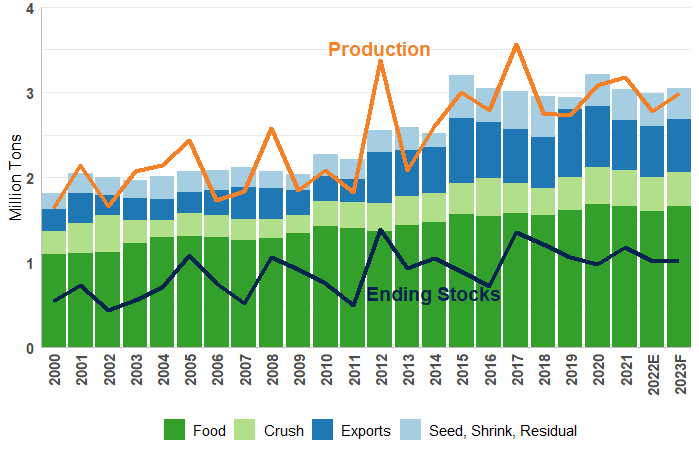Forecast by Wendiam Sawadgo, Auburn University and Alabama Cooperative Extension System, Assistant Professor and Extension Economist; and Adam N. Rabinowitz, Auburn University and Alabama Cooperative Extension System, Associate Professor and Extension Economist.
Main Takeaways
- Peanut yields were down in 2023, but demand continues to remain strong and stocks remain steady at just over 1 million tons. Prices are expected to hold strong.
- The increased cost of production in recent years has remained elevated, with the Farm Bill safety net providing no support.
- Contracting, controlling costs, and careful evaluation of crop insurance are primary risk-management strategies for producers.
2024 Peanut Outlook
The peanut market remained strong in 2023, but high input costs remained a major challenge. Contracts were largely in the $500 to $550 range for runner peanuts for a second consecutive year. However, production costs rose once again to a level such that farmers struggled to make a profit even with decade-high peanut prices.
Despite large increases in planted peanut acreage across the United States, below-average yields are expected to limit production to a moderate increase. In the 2023–2024 marketing year, there was a 14% increase in planted peanut acres nationwide, to 1.65 million acres. Georgia—the nation’s leading peanut producer—planted 775,000 acres of peanuts in 2023, a 90,000-acre increase. In 2022, peanuts faced strong competition for acreage because of high cotton prices, which surpassed $1 around planting time. However, this competition faded in 2023 as cotton prices lagged in the 80¢ range and corn prices also tumbled.
U.S. peanut yields are projected to reach just 3,740 lb per acre, well below the 10-year average of 3,942 lb per acre. This year’s national peanut yield would be the lowest since 2016, driven by 24% and 26% decreases compared to last year in Alabama and Florida, the third- and fourth-leading peanut states in terms of acreage planted. In Georgia, peanut yields are expected to be down 3% from last year at 4,100 lb per acre, the lowest Georgia yield since 2016. U.S. peanut production is projected to increase by only 7% to 2.99 million tons (Figure 1). Georgia is expected to increase production to 1.6 million tons, an increase of 150,000 tons.

Data sources: USDA ERS Oil Crops Outlook; USDA World Agricultural Supply and Demand Estimates.
The quality of runner peanuts also has been impacted in 2023. In Georgia, 0.3% of production was graded as Seg-2 and 0.1% of production as Seg-3 as of December 19, 2023. Meanwhile, across the United States, a total of 1% of runner peanuts were not Seg-1, with 0.7% as Seg-3 mainly because of drought conditions in Alabama. These are more than double the Seg-2 and Seg-3 rates seen in the past 2 years but still not quite as high as 2019 when it accounted for 2.5% of U.S. runner production. Georgia also was affected by Hurricane Idalia, which resulted in $28 million of indemnity payments on the 217,093 peanut acres covered by the Hurricane Insurance Protection – Wind Index (HIP-WI). However, only 37% of covered acres were also covered by additional endorsements (HIP-WI or SCO).
Peanut stocks are expected to remain unchanged at just over 1 million tons because peanut disappearance (projected to increase to 3.05 million tons) this marketing year is expected to roughly equal increased production. Peanut exports are expected to increase by 5%, food disappearance by 4%, and crush by 1%. During the 2022–2023 marketing year, strong peanut food use was driven by a 5% increase in disappearance to peanut butter, despite 10% and 6% decreases in consumption for peanut candy and peanut snacks. This is important because peanut butter accounts for about half of the peanut disappearance to food. Over the first 3 months of the 2023–2024 marketing year (August through October), peanut butter production was up 5% over the same period in the previous year, while peanut candy is down 1%, peanut snacks are down 6%, in-shell peanuts are up 3%, and other peanut edible products are up 6%.
Peanut prices are expected to remain elevated and set a 10-year high for a second consecutive year. The 2023–2024 marketing year average farm price is projected at $550 per ton, which would be a $14 per ton increase from the previous period. Despite this, peanut profitability remains a challenge. In 2022, the U.S. Department of Agriculture estimated Alabama and Georgia peanut production operating costs at $696.21 per acre, plus $495.01 of allocated overhead. While some costs eased in 2023, they have not returned to prior levels and overall costs were higher.
The farm bill safety net provisions in Title I also have not provided relief for rising peanut input costs. If the projected $550 per ton price is realized, the 2023 program year would mark the second straight year without a price loss coverage (PLC) payment on peanut base acres. The effective reference price (ERP) does allow for an increase in the PLC reference price under sustained higher prices relative to the statutory reference price. However, this has not yet occurred for peanuts and with the 1-year extension of the farm bill, no change in the reference price for peanuts will occur for the 2024 program year. Given expected peanut prices, it is likely there will be no PLC peanut payments for the 2024 program year either (payment in October 2025). Producers need to look toward other risk-management strategies such as forward contracting, input cost minimization, and crop insurance coverage to help mitigate the risk of growing peanuts.
Status and Revision History
In Review on Jan 19, 2024
Published on Jan 22, 2024


























































